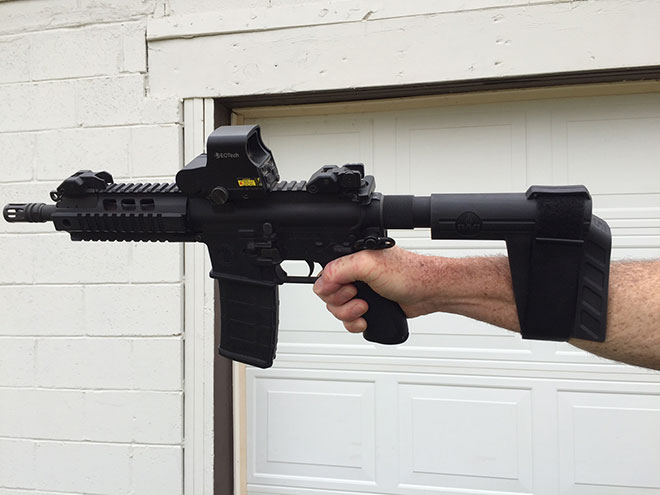
SB Tactical’s SBX-K pistol brace mounted on the Sig 516. (Photo: Team HB)
Fascination surrounds short barreled rifles and the compact platform has seen an uptick in interest over the years. As the internet emerged and provided gun owners with more resources and better information regarding the platform, the process to ownership became less intimidating and more accessible. It’s no wonder that when a new contender entered the market, offering similar benefits to the traditional SBR but without the ATF registration, gun owners pounced.
The pistol stabilizing brace, launched in 2013, set the gun world on fire. Originally developed by Alex Bosco of SB Tactical, the brace was meant to offer more stability for wounded and disabled veterans shooting AR pistols.
Bosco quietly introduced the design on AR15.com to determine interest, but little did he know the brace would cause such an uproar.
“In early December I went online to AR15.com and posted information on the stabilizing brace and a link to where people could find it. It received 50,000 hits, and within 48 hours the website crashed because of traffic and email inquiries asking how to purchase one,” Bosco told America’s 1st Freedom. “SB Tactical was off and running.”
Prior to the stabilizing brace’s online forum launch, Bosco had written to the ATF seeking approval of the new design.
“I immediately wrote to the ATF for approval. I had sent them a photo of the brace on an airsoft gun because I couldn’t afford a real AR-15. The letter was mailed on Nov. 17, 2012, and on Nov. 27 I received a letter back saying my design was approved.”
In the months after the stabilizing brace plowed its way into the industry, Bosco was approached by gun makers looking to distribute the product. After meeting with several at SHOT Show in January 2013, Sig Sauer was chosen as SB’s new distributor and business took off.
“At the convention, several different companies expressed interest in carrying the Stabilizing Brace, but SIG Sauer was committed to it. They truly understood how we wanted to empower disabled shooters, wounded veterans and others in need, and restore their ability to shoot,” Bosco commented. “We signed an initial three-year contract for delivery of about 140,000 units. They sold them all in the first year.”
Century Firearms soon followed, offering the brace for its AK pistol platform.
When the stabilizing brace was introduced, opportunistic gun owners saw a loophole. Under National Firearm Act regulations, short barreled rifles, which are those with barrels under 16 inches or with an overall length of less than 26 inches, must be registered with the ATF and be accompanied by a $200 tax stamp. The SBR designation also prevents travel with the firearm in certain states that restrict SBR ownership. SBR fanatics realized that the stabilizing brace allowed them to circumvent NFA laws.
Before long, SBR fans were buying pistol carbines equipped with stabilizer braces and shouldering them as they would a traditional rifle. Though the ATF was aware of the uses, the agency initially maintained the stabilizing brace could be shouldered without crossing into SBR territory as they were unrelated designs.
Then, just days before SHOT Show in January 2015, the ATF published a letter clarifying its position on the stabilizing brace versus SBR.
“The pistol stabilizing brace was neither ‘designed’ nor approved to be used as a shoulder stock, and therefore use as a shoulder stock constitutes a ‘redesign’ of the device because a possessor has changed the very function of the item,” the letter, signed by Acting Chief Max Kingery, read.
The hammer was dropped and gun owners were forced into two options: use the brace as intended only on the forearm or register the weapons system with the ATF as an SBR.
“It is not illegal to use or possess a pistol brace, provided it is used in the manner in which it was intended. If an individual were to have an approved Form 1 or attach a brace to an approved Form 1 firearm, it would be acceptable for them to shoulder it as the firearm is a registered short barrel rifle,” Noted firearms attorney Adam Kraut told Guns.com in an email.
“That said, I don’t agree with ATF’s interpretation but I don’t think anyone really wants to step up to the plate and become a test case to challenge it,” he added.
Braces continue to be offered by gun makers and SB Tactical has even jumped into the distribution chain, offering more products. The devices can be fun and cheap alternatives to typical long rifles or short-barreled designs, so long as consumers understand the caveats and keep the brace on the forearm where it belongs.
The post How pistol stabilizing braces differ from short-barreled rifles appeared first on Guns.com.
